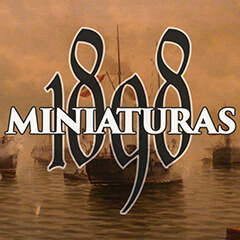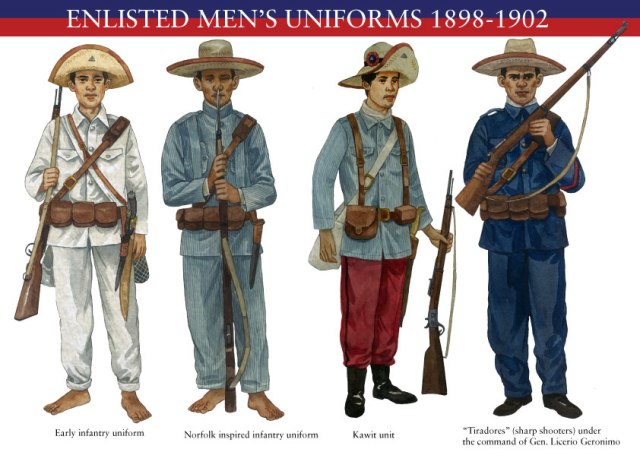Filipino uniforms 1896-1902. Katipunan and Republican Army
1898 Miniaturas

Filipino uniforms 1896-1902. Katipunan and Republican Army
This article intends to give a brief description of the Filipino uniforms of the combatants who first confronted the Spaniards (1896-1898), –mainly Katipunan fighters who lacked much drill and equipment– and later to the Americans (1899-1902 ), now as the Philippine Republican Army.
Filipino uniforms: soldiers
At the beginning of the Philippine revolution in August 1896, the bulk of the Katipunan fighters consisted mainly of civilians dressed in their local garb, mainly blouses and knee-length trousers in off white, buff, gray and red. These were joined by Filipino soldiers from the Native regiments of the Spanish Army who deserted by thousands, taking with them their weapons (Remington rifles) and their rayadillo uniforms, which cohabited with local uniforms of similar pattern, but white in color.
After the fall of Manila in August of 1898, the revolutionaries assaulted the Spanish arsenals and equipped themselves with rayadillo uniforms and Spanish armament. In addition, the Philippine Republican Army began to uniform itself with Norfolk jackets of local manufacture, characteristics by their folds and their vertical pockets in the chest, in white cloth or rayadillo. The soldiers were in the habit of going barefoot, which in practice also occurred among the Filipino recruits of the Spanish Native regiments. Illustrations: Museum of the Palace of Malacañang.
Filipino uniforms: officers
Until 1898, the few photos that are preserved show us officers wearing simple coats with a standing or rolled collar and pockets in the skirts, in white cloth or rayadillo. Also we have some models of rayadillo jackets with folds in the chest and the back and pockets in the skirts, inspired by the guayabera used by the Spaniards in Cuba but with a standing collar.
From 1898, however, the use of Norfolk jackets with vertical chest pockets in white cloth or rayadillo, in its different versions including folds and pockets in the skirts, will be popularized amongst officers. Illustrations: Museum of the Palace of Malacañang.
Filipino Army insignia of rank
Regarding insignia of rank, we can distinguish between three periods: early Katipunan army, corresponding to the first moments of the uprising; late Katipunan army, since October 1896; Filipino Republican Army, since 1898.
Early Katipunan Army
Rank insignia consisted of a complex system of symbols and initials worn in red bracelets and red patches sewn on the chest. Illustration based on Pedro Antonio V. Javier research, source ¡Rayadillo! The Spanish Colonial Uniform Research Project.
Late Katipunan Army
In October of 1896 the complex previous designs began to be progressively changed. The new insignia of rank consisted of a series of red braids and loops in the cuffs for the officers; and red chevrons for the NCO, according to photos of the time sewn in the upper arm. Illustration based on Pedro Antonio V. Javier research, source ¡Rayadillo! The Spanish Colonial Uniform Research Project.
Filipino Republican Army
With the declaration of war of the United States and the new outbreak of the revolution in 1898, the new Republican Army, which integrated multiple factions in addition to the Katipunan, establishes a system of shoulder pads in the branch color (red for the infantry) with gold or silver stars. We found evidence of rayadillo shoulder pads with the stars sewn over a circle of cloth in the blanch color. The NCO chevrons became green, with double stripe for corporals and triple for sergeants. Illustration: Museum of the Palace of Malacañang.
Headdress
The headdress most used by the Filipino armies was the wide-brimmed hat, similar to that used by the Spanish troops, frequently decorated with a red lace running over the wing, and a black ribbon wearing the national red and blue cockade. Likewise, it is frequent to see in the photographs the use of wooden conical hats typical of the Filipino peasants. The use of white cloth caps with visor and sunhats will be especially popular among the officers. Illustration: Museum of the Palace of Malacañang.
Sources
Museum of the Presidencial Palace of Malacañang, Manila.
Philippine-American War 1899-1902, Arnaldo Dumindin website
¡Rayadillo! The Spanish Colonial Uniform research project, William Combs website












